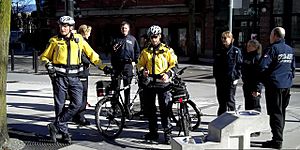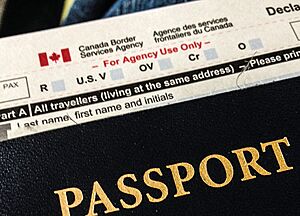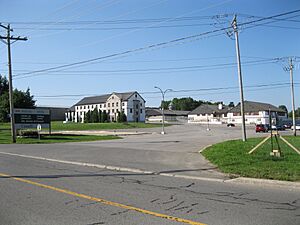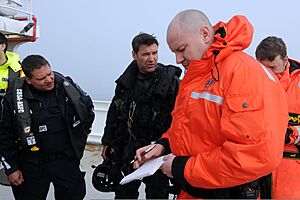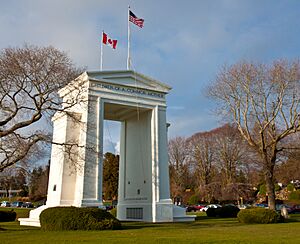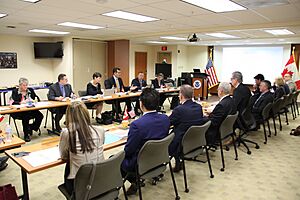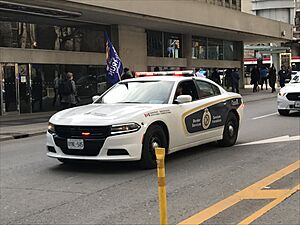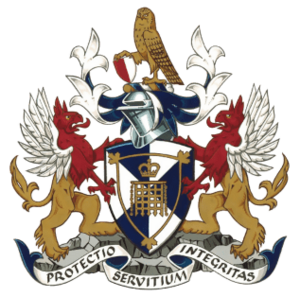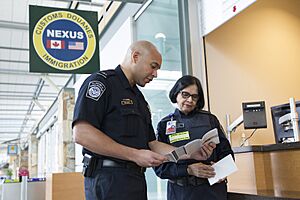Canada Border Services Agency facts for kids
Quick facts for kids Canada Border Services AgencyAgence des services frontaliers du Canada |
|
|---|---|
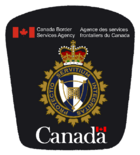
Shoulder flash of the CBSA
|
|
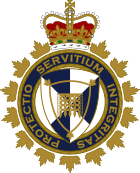
Badge of the CBSA
|
|
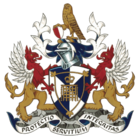
CBSA coat of arms
|
|

Flag of the CBSA
|
|
| Common name | Border Services |
| Abbreviation | CBSA (French: ASFC) |
| Motto | Protectio Servitium Integritas (Latin for "Protection, Service, Integrity") |
| Agency overview | |
| Formed | 12 December 2003 |
| Preceding agencies |
|
| Employees | 15,441 |
| Annual budget | CA$2.2 billion |
| Jurisdictional structure | |
| Federal agency | Canada |
| Operations jurisdiction | Canada |
| Governing body | Public Safety Canada |
| Constituting instruments |
|
| General nature | |
| Operational structure | |
| Headquarters | Ottawa, Ontario |
| Elected officers responsible |
|
| Agency executive |
|
| Regions |
8
National Headquarters: Ottawa
Pacific Region: British Columbia & Yukon Prairie Region: Alberta, Saskatchewan, Manitoba & Northwest Territories Windsor/St. Clair Region Niagara/Fort Erie Region Greater Toronto Region Northern Ontario Region: Northern Ontario & Nunavut Quebec Region: Quebec Atlantic Region: Prince Edward Island, New Brunswick, Nova Scotia, Newfoundland & Labrador |
The Canada Border Services Agency (CBSA) is a government agency in Canada. It is in charge of keeping Canada's borders safe. This includes checking people and goods entering or leaving the country. It also handles immigration rules and customs services.
The CBSA reports to the Parliament of Canada through the Minister of Public Safety. Currently, this minister is Dominic LeBlanc. The agency is led by its president, Erin O’Gorman.
The CBSA started on December 12, 2003. It brought together different tasks from other agencies. These included customs from the Canada Customs and Revenue Agency. It also took over immigration enforcement from Citizenship and Immigration Canada. And it handled border checks for food from the Canadian Food Inspection Agency. The CBSA's official creation was made legal by the Canada Border Services Agency Act in 2005.
The CBSA has about 1,200 locations across Canada. It also has 39 locations in other countries. Over 14,000 people work for the agency. They offer 24-hour service at 117 land border crossings. They also work at 10 of the 13 international airports they serve. The CBSA works with Immigration, Refugees and Citizenship Canada. They help remove people who are not allowed to be in Canada. They also help police with investigations related to immigration laws.
The CBSA's Inland Enforcement branch finds and removes people who are in Canada illegally. The agency also manages three major sea ports. It runs three mail centers and special holding centers for immigrants. These centers are in Laval, Toronto, and Surrey.
Contents
- History of the CBSA
- Rules and Laws
- How the CBSA Works
- How the CBSA is Organized
- Symbols and Badges
- Trade and Business
- See also
History of the CBSA
Before 2004, three different agencies handled border security in Canada.
- Canada Customs and Revenue Agency (CCRA) handled customs.
- Citizenship and Immigration Canada (now IRCC) handled immigration enforcement.
- Canadian Food Inspection Agency (CFIA) checked imports at border points.
The Auditor General pointed out problems with this setup. For example, the agencies could not easily share security information. Communication between them was also difficult. So, in 2003, these border tasks were combined into one agency. This new agency was called the Canada Border Services Agency. Alain Jolicoeur became its first president.
When the CBSA was formed, the CCRA's tax collection duties went to the Canada Revenue Agency. Its customs duties were fully taken over by the CBSA. Since then, the agency has changed a lot. Its structure, duties, and main goals have all been updated.
Arming Officers
When the CBSA first started, its officers did not carry firearms. This was similar to the CCRA officers before them. This changed in 2006. The Canadian government approved a plan to arm and train Border Services Officers (BSOs). This plan was called the CBSA Arming Initiative. It was a 10-year strategy.
One of the first big changes was allowing CBSA officers to arrest people at the border. They could now arrest people for non-customs violations of Canadian law. These new duties led to rules about using force. BSOs across Canada began to carry batons, pepper spray, and handcuffs. It took several years before they were given firearms. The 2006 Canadian federal budget provided money for BSOs to carry side arms. It also helped to stop single-person border crossings.
The chosen sidearm for officers is the Beretta Px4 Storm.
How Arming Happened
In August 2006, Prime Minister Stephen Harper announced the arming of BSOs. It began in early 2007 and finished in 2016. The busiest or most dangerous border points were armed first. For example, officers at the Windsor-Detroit border crossing in Ontario were among the first to be armed. This is Canada's busiest highway border crossing.
By 2019, all Border Services Officers at border crossings were given duty firearms. However, BSOs working inside major airport terminals are not allowed to carry their firearms. They must store them safely.
2021 Strike
In August 2021, about 8,500 CBSA employees went on a strike. They were part of the Public Service Alliance of Canada and the Customs and Immigration Union. The strike happened just before COVID-19 border rules were set to ease. The workers had not had a new contract since 2018. They asked for higher salaries, similar to other law enforcement officers in Canada. They also wanted better protection against discrimination. And they wanted non-uniformed staff to be able to work from home. An agreement was reached later the same day, ending the strike quickly.
Rules and Laws
Reviewing Complaints
A government report in 2017 suggested creating a new independent group. This group would watch over the CBSA and investigate complaints against it. Right now, the CBSA does not have an independent civilian oversight group. This is unusual because most police agencies in Canada have some form of independent review.
The government announced in 2019 that it would spend money to expand an existing commission. This commission, the Civilian Review and Complaints Commission for the Royal Canadian Mounted Police, would then review complaints for both the RCMP and the CBSA. However, the proposed law did not pass before the parliamentary session ended.
Digital Privacy at the Border
Search Rules
The CBSA has changed its rules for searching electronic devices. New rules include:
- Devices should only be searched in airplane mode.
- Officers should not access apps or software that connect to "the cloud."
- Officers must write detailed notes before, during, and after a search.
- Officers must be well-trained and follow CBSA policies.
- Officers must explain why they are searching a device in their notes.
- If you feel you are in legal trouble, you can ask to speak with a lawyer.
- Files marked as 'solicitor-client privilege' (private legal advice) will not be searched immediately. A court might need to inspect the device.
Changes to Rules
On January 7, 2020, Privacy Commissioner Daniel Therrien stated that the CBSA had broken the law. He said they conducted searches of personal digital devices that were too invasive. Therrien suggested that the rules for searching digital devices should be written into the Customs Act. He believes that a search should only happen if there are "reasonable grounds to suspect" a crime or customs violation. The CBSA responded by releasing statistics on device searches. Some legal experts have questioned if these numbers are accurate.
How the CBSA Works
| Position | Insignia | Pay Grade |
|---|---|---|
| Officer Trainee | No insignia | FB-02 |
| Border Services Officer (BSO)
(usually referred to as Officer) |
No insignia | FB-03 |
| Trainer | 1 silver stripe | FB-04 |
| Superintendent | 2 standard silver stripes | FB-05 |
| Training Administrator | ||
| Regional Program Manager | 3 standard silver stripes | FB-06 |
| Chief of Operations
(commanding officer of a point of entry, either land or airport) |
3 standard silver stripes | FB-07 |
| Training Manager | ||
| Assistant Director | 3 standard silver stripes | FB-08 |
| Director
(commanding officer of a district: multiple land borders or an airport) |
1 gold CBSA pin and 1 gold pip | EX-02 |
| Regional Director General (RDG)
(commanding officer of a region, e.g. Pacific Region, Prairie Region) |
1 gold CBSA pin and 2 gold pips | EX-03 |
| Vice President (of operations) | 1 gold CBSA pin and 3 gold pips | EX-04 |
| President
(head of the CBSA) |
1 gold CBSA pin and 4 gold pips |
Border Services Officers
A Border Services Officer (BSO) is a federal law enforcement officer. They work for the Canada Border Services Agency. BSOs have different legal titles. They are "Customs Officers" under the Customs Act. They are also "Immigration Officers" under the Immigration and Refugee Protection Act. And they are "Screening Officers" under the Quarantine Act.
When BSOs enforce customs or immigration laws, they are considered Peace Officers. This is under the Criminal Code. However, they can only make arrests for Criminal Code offenses if they are specially appointed. This happens when they are performing their normal duties at customs offices.
Currently, BSOs carry handcuffs, pepper spray, batons, and Beretta PX4 Storm pistols. The plan to arm officers began in 2007 and finished in 2016. BSOs are trained at the CBSA College in Rigaud, Quebec. Their training starts with a 4-week online program. Then, they complete an 18-week program. This program covers laws like criminal law, immigration, and customs. It also teaches control and defensive tactics.
Immigration Duties
The CBSA is very important for immigration to Canada. It took over the duties of checking people at the border and enforcing immigration rules. These tasks used to belong to Citizenship and Immigration Canada. CBSA officers are the first point of contact. They screen people entering Canada. They also remove those who are not allowed to be in the country.
At the end of 2003, there were many people in Canada without legal status. Most of these were people whose refugee applications were denied. Very few people enter Canada illegally without being checked by the CBSA. This is because Canada is hard to reach, except by crossing the Canada/U.S. border. Since the U.S. is also a popular place for people without legal status, not many try to cross into Canada illegally through wild areas.
Recently, more people have been entering illegally from St. Pierre & Miquelon. They travel in small, makeshift boats. High unemployment in this French territory has caused this increase. The CBSA and Royal Canadian Navy are looking into increasing patrols to stop these illegal crossings. While residents could legally travel to France, airfare is expensive. So, the short boat ride to Newfoundland and Labrador is more appealing for those looking for work.
Checks, Searches, and Seizures
All people and goods entering Canada can be checked by CBSA officers. A check can be as simple as a few questions. But it can also include checking a person's vehicle, luggage, or electronic devices. It might involve more detailed questions or even strip-searches. How intense a check is depends on whether the officer has a good reason to suspect something. CBSA Officers must follow strict rules and procedures during these checks.
Checks are done to make sure people follow customs and immigration laws. CBSA officers get their authority from the Customs Act and the Immigration and Refugee Protection Act (IRPA). BSOs can also enforce other Acts of Parliament. This is because they are considered Peace Officers under the Criminal Code.
Enforcement and Intelligence
Intelligence Work
The CBSA has a strong Intelligence program. Its job is to give quick, correct, and useful information to decision-makers. This information helps the agency make choices at all levels. Information is gathered legally from many places. These include public and private sources, and other intelligence groups. They also work with other law enforcement agencies. They use special tools, hidden surveillance, and information from people. Intelligence officers and analysts work across Canada and overseas.
The agency uses this information to understand risks. They use automated analysis and risk management tools. This helps them balance security with allowing people and goods to move easily. They manage risks by collecting and analyzing information. They also use detection tools, officer judgment, and random checks.
The intelligence team checks border risks every 2–3 years. They look at risks like smuggling firearms, illegal money, or tobacco. They also include risks of illegal immigration and the movement of food, plants, and animals. The agency also checks the risk level of its 168 border points every two years.
The intelligence team also provides daily, weekly, and monthly updates. These updates are about specific threats and illegal activities. Intelligence officers often help with law enforcement tasks. These include search warrants, arrests, surveillance, and interviewing detainees.
Border Watch Program
The CBSA Border Watch toll-free phone line lets people report suspicious activity at the border. This is done directly and privately. The Border Watch line is different from other public phone lines like CrimeStoppers. It focuses only on border-related information.
Detector Dog Service (DDS)
Detector dogs start training between 11 and 16 months old. They usually work for 8 to 10 years. The CBSA uses different breeds like Labrador Retrievers and Beagles. The dogs live with their handlers full-time. At work, they travel in special air-conditioned vehicles.
The CBSA started using detector dogs in 1978. There were three dog units at the Windsor border crossing. Now, there are 69 detector dog teams across Canada. These dogs work in mail centers, airports, land crossings, and marine facilities. Each dog is trained to find specific things. They usually fit into one of four groups:
- Illegal substances, explosives, and firearms
- Money
- Tobacco
- Food, plants, and animals (FPA)
What Detector Dogs Do
Detector dogs are one of the best tools for finding illegal items. They are very good at finding the source of a smell. This saves time during checks of vehicles, luggage, and cargo. This makes the process faster for officers and for travelers.
The CBSA uses "passive" detector dogs. This is different from some other law enforcement agencies that use "active" dogs. When a passive dog finds a smell it is trained to recognize, it sits next to the source. Active dogs bark, scratch, or bite. Passive dogs allow officers to work more calmly among people. The CBSA believes passive dogs are more effective. Passive dog training started in 1993 and is now the agency's preferred method.
Dog Training
Detector Dog teams (one dog and one handler) go through a 10-week training course. This happens at the CBSA Learning Centre. The handlers are Border Services Officers. They learn how to care for, keep, and train their dogs. They also learn about the "Cone of Scent." This means smell particles spread out in a cone shape. They are stronger at the source and weaker farther away. After the first training, handlers must keep training their dogs. This ensures the dogs stay in top form. Only about 1 in 10 dogs that start training become detector dogs.
The CBSA looks for certain traits in a potential detector dog:
- Good at fetching and wanting to fetch
- Healthy body condition
- Alertness
- Friendly
- Brave
- Good behavior
Canada–US Cooperation
A main reason for creating the CBSA was to improve security after 9/11. Canada wanted to show it was doing enough to keep North America safe. The United States had already made big changes after the 2001 attacks. As a result, the U.S. created the Department of Homeland Security (DHS). Its leader, Secretary Tom Ridge, worked with Canada's Deputy Prime Minister, John Manley. Together, they created the Smart Border Declaration in December 2001. This declaration set goals for cooperation between Canadian and American border operations.
Smart Border Declaration and Action Plan
The Smart Border Declaration and Action Plan, also known as the Smart Border Accord, was signed in 2001. It is a plan between the Government of Canada (CBSA, RCMP, and Department of Foreign Affairs) and the United States Government (DHS, CBP, and U.S. Coast Guard). The main people who signed it were Canadian Deputy Prime Minister John Manley and U.S. Director of Homeland Security Tom Ridge.
The agreement was made to make it easier for people and goods to cross the border. It has 30 points to improve both security and trade. For example, it includes improving biometric features on Permanent Resident Cards. It also involves sharing travel information and creating similar immigration databases.
The Action Plan has four main parts:
- Making the movement of people safe.
- Making the movement of goods safe.
- Investing in secure buildings and systems.
- Working together and sharing information to meet these goals.
Canada–United States Integrated Border Enforcement Teams
Integrated Border Enforcement Teams (IBETs) were created as part of the Accord. They combine the skills of different law enforcement and intelligence agencies from both countries. IBETs include members from the CBSA, RCMP, CBP, U.S. Coast Guard, and U.S. ICE Teams. They also get help from other local, state/provincial, and federal agencies for certain projects.
In Canada, IBETs work in 15 areas along the Canada-U.S. border. They operate in air, sea, and land. They are based on a model that started in 1996 along the B.C.-Washington state border. Since they began, IBETs have helped stop several smuggling groups.
The CBSA uses various vehicles for its operations. The Dodge Charger is used by the Inland Enforcement Program. The Ford Explorer, Ford Police Interceptor Sedan, Dodge Caravan, and Ford F-250 are used at border crossings. Other vehicles include the Chevrolet Impala, Chevrolet Tahoe, Ford F-350, Ford E-250, Dodge RAM, Chevrolet Silverado, and a Navistar International HV used as an X-RAY truck.
How the CBSA is Organized
CBSA Regions and Departments
The CBSA has seven regions across Canada: Atlantic, Greater Toronto Area, Northern Ontario, Pacific, Prairie, Quebec, and Southern Ontario. The agency has nine main departments and one group that report directly to the President.
- CBSA Assessment and Revenue Management
- Chief Transformation Officer
- Commercial and Trade
- Finance and Corporate Management
- Human Resources
- Information, Science and Technology
- Intelligence and Enforcement
- Internal Audit and Program Evaluation (direct report)
- Strategic Policy
- Travellers
CBSA Leadership
Erin O’Gorman became the President of the CBSA in July 2022. Before this, she held senior roles at the Treasury Board of Canada Secretariat from 2018 to 2022. She also worked at Natural Resources Canada and Transport Canada. She held positions with the Privy Council Office as well.
Symbols and Badges
The CBSA uses special symbols, like other law enforcement agencies. These symbols are granted by the Canadian Heraldic Authority.
The coat of arms was given on June 15, 2010. Queen Elizabeth II presented it on July 6, 2010. This was the Queen's last event during her 2010 Canadian Royal Tour. The Governor General Michaëlle Jean and Prime Minister Stephen Harper were also there. The coat of arms is used for special events and is linked to the CBSA president's office.
The heraldic badge was also approved at the same time. It has a gold border, which stands for the agency's focus on security. The portcullis (a gate) represents the Queen's agents who work at the border. The Latin motto Protectio Servitium Integritas means "Protection, Service, Integrity" in English. This badge is shown often in the TV show Border Security: Canada's Front Line.
A flag was given to the CBSA on December 20, 2012. It looks like the Canadian Blue Ensign. This flag was flown on government ships (including those patrolling Canada's waters) before 1965.
Trade and Business
Customs Act
| Customs Act | |
|---|---|
| An Act respecting Customs | |
| Citation | R.S.C., 1985, c. 1 (2nd Supp.) |
| Date assented to | 13 February 1986 |
| Date commenced | 1867 |
| Status: Substantially amended | |
The Customs Act (1985) is a key law for the CBSA. It was first passed in 1867 to:
- Make sure duties (taxes on imports) are collected.
- Control how people and goods enter and leave Canada.
- Protect Canadian businesses from unfair competition.
The Customs Act itself does not set taxes. Instead, it gives the CBSA the power to collect duties and taxes set by other laws. These include the Customs Tariff and other tax acts. The Act was updated in 1986 to be more flexible for modern trade and business. It has been changed many times since then due to free trade and other international agreements.
Customs Self Assessment
The Customs Self Assessment program helps approved importers. It makes the process of accounting and paying for imported goods simpler. Importers must apply to join this program.
Advance Commercial Information
Advance Commercial Information (ACI) is a big project by the CBSA. It requires cargo entering Canada by water and air to be registered with the agency. This helps officials at seaports and airports with their inspections. The program allows them to track suspicious materials. These parts of the project started in 2005. A similar program for highway and rail cargo is planned for the future.
ACI is similar to the United States' Automated Manifest System (AMS). The goal is to make border security and efficiency better. Once fully in place, ACI will require all commercial cargo entering Canada to be registered electronically with the CBSA.
See also
 In Spanish: Agencia de Servicios Fronterizos de Canadá para niños
In Spanish: Agencia de Servicios Fronterizos de Canadá para niños
- Royal Canadian Mounted Police
- Visa policy of Canada
- Tourism in Canada
- List of Canada–United States border crossings
- US entry into Canada by land
- NEXUS
- CANPASS
- Passport Canada
- Correctional Service of Canada
- Global Affairs Canada
- US Customs and Border Protection
- UK Visas and Immigration


